“A Worldwide Circle of Sisterhood,” Daughters in My Kingdom: The History and Work of Relief Society (2011), 81–102
“Chapter 6,” Daughters in My Kingdom, 81–102
Chapter 6
A Worldwide Circle of Sisterhood
When the Prophet Joseph Smith met with Relief Society sisters in Nauvoo, he taught that in addition to giving temporal service, they were to strengthen people spiritually (see chapter 2). With this counsel as a foundation, Relief Society sisters have found love and safety from the storms of life as they have served together. They have shared the gospel of Jesus Christ with each other and with those around them. Relief Society has become a shelter from the world—a place of refuge—and a center of light to the world—a place of influence.
In a Relief Society meeting in Ogden, Utah, Sister Eliza R. Snow, the second Relief Society general president, gratefully acknowledged sisters’ efforts to strengthen one another temporally and spiritually. She told them that although the Church did not keep a record of every donation they made to help those in need, the Lord kept a perfect record of their saving work:
“I am well aware that a great deal is donated that never reaches the [record] books. President Joseph Smith said this society was organized to save souls. What have the sisters done to win back those who have gone astray?—to warm up the hearts of those who have grown cold in the gospel?—Another book is kept of your faith, your kindness, your good works, and words. Another record is kept. Nothing is lost.”1
A heavenly record is kept of the work of Relief Society sisters as they reach out to those whose hearts have grown cold and who need faith, kindness, good works, and good words.
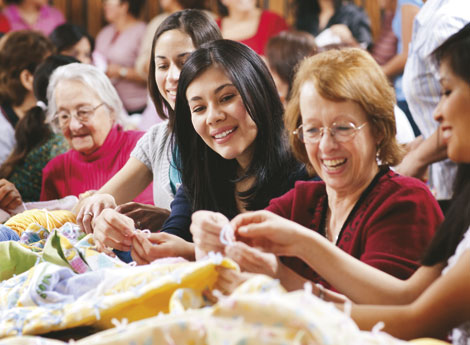
Relief Society sisters find love and safety from the storms of life as they serve together.
Worldwide Sisterhood
“You are chosen to be faithful women of God in our day, to stand above pettiness, gossip, selfishness, lewdness, and all other forms of ungodliness. Recognize your divine birthright as daughters of our Heavenly Father.”
Howard W. Hunter
Ensign, Nov. 1992, 97
In the mid-1900s, as the world suffered the effects of wars and natural disasters, the Relief Society’s work continued to expand. True to the purposes of the organization—increasing faith and personal righteousness, strengthening families and homes, and seeking out and helping those in need—the Relief Society provided a refuge for Latter-day Saint sisters and was an influence for good. In 1947 the general Relief Society presidency (Sisters Belle S. Spafford, Marianne Sharp, and Gertrude Garff) taught, “Ours is a healing mission requiring the larger heart, the kindlier touch, the steadier will.”2
At that time, some governments established political restrictions and even built some physical barriers. These restrictions and barriers, known by names such as the Iron Curtain and the Berlin Wall, were designed to restrict some people and exclude others. In contrast, Relief Society sisters built spiritual walls of refuge designed to protect and include. They came together in a worldwide circle of sisterhood and invited others to join them.
Even in countries with political boundaries and laws that prevented open participation in religion, members of Relief Societies felt a connection to their sisters throughout the world. They quietly remained true to their testimonies of the restored gospel and to the purposes of Relief Society.
In 1980, President Boyd K. Packer of the Quorum of the Twelve Apostles and his wife, Donna, visited a Relief Society in Czechoslovakia (now the Czech Republic and Slovakia). He later recalled:
“It was not easy to obtain visas, and we used great care so as not to jeopardize the safety and well-being of our members, who for generations had struggled to keep their faith alive under conditions of unspeakable oppression.
“The most memorable meeting was held in an upper room. The blinds were drawn. Even at night, those attending came at different times, one from one direction and one from another, so as to not call attention to themselves.
“There were in attendance 12 sisters. We sang the hymns of Zion from songbooks—words without music—printed more than 50 years before. [A lesson] was reverently given from the pages of a handmade manual. …
“I told those sisters that they belonged to the largest and by all measure the greatest women’s organization on earth. I quoted the Prophet Joseph Smith when he and the Brethren organized the Relief Society. …
“The Spirit was there. The lovely sister who had conducted with gentility and reverence wept openly.
“I told them that upon our return I was assigned to speak at a Relief Society conference; could I deliver a message from them? Several of them made notes; each expression, every one, was in the spirit of giving—not of asking for anything. I shall never forget what one sister wrote: ‘A small circle of sisters send their own hearts and thoughts to all the sisters and begs the Lord to help us go forward.’
“Those words, circle of sisters, inspired me. I could see them standing in a circle that reached beyond that room and circled the world.”3
Recalling that meeting, President Packer said, “I stood, for a moment, in that circle and felt the impulses of faith and courage and love coming and going on either side.”4
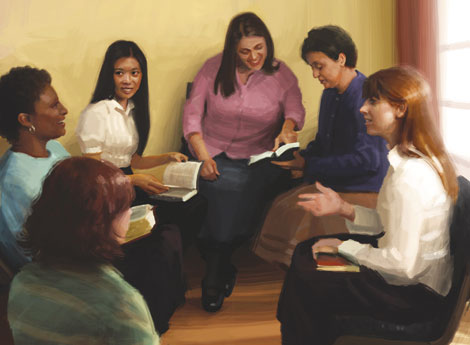
Members of the Relief Society come together in a circle of sisterhood.
Circle of Sisters, by David Dibble. © David Dibble.
Such faith and courage and love combine to form the heritage of Relief Society sisters everywhere. President Henry B. Eyring, a counselor in the First Presidency, encouraged Relief Society sisters to share this heritage. “You pass the heritage along as you help others receive the gift of charity in their hearts,” he said. “They will then be able to pass it to others. The history of Relief Society is recorded in words and numbers, but the heritage is passed heart to heart.”5 This happens in Relief Society’s circle of sisterhood.
A Place of Refuge
Since the early days of Relief Society, sisters have provided a place of refuge—a place of healing, love, kindness, care, and belonging. In Nauvoo, sisters found refuge in Relief Society as they relied on each others’ faith and skills and as they shared food and clothing. This continued as they crossed the plains and as they established themselves in the Utah Territory. Now, as the Church grows throughout the world, sisters continue to find refuge in Relief Society.
President Boyd K. Packer said: “This great circle of sisters will be a protection for each of you and for your families. The Relief Society might be likened to a refuge—the place of safety and protection—the sanctuary of ancient times. You will be safe within it. It encircles each sister like a protecting wall.”6
In 1999, Bobbie Sandberg, a young wife and mother, moved with her family from the United States to Taiwan. Although she would be there for only six months while she and her husband taught an English class, her Taiwanese sisters encircled her in the protective influence of Relief Society.
This protection was especially evident when a terrible earthquake shook the country, with its epicenter near the Sandbergs’ home. Buildings tumbled down on both sides of the school where they lived. Within hours of the first big jolt, Sister Sandberg’s Relief Society president came to the family like an angel of mercy to assess their needs and help them. Because many of the roads and buildings had been destroyed and all communication lines were down, this caring president used the only means of transportation she could find. She rode her bicycle through the rubble until she had visited many sisters in the ward.
In the midst of physical turmoil, Sister Sandberg was under the safe protection of a Relief Society. Her Relief Society president cared about the safety and needs of each sister in her ward.
Like Sister Sandberg, many Latter-day Saints around the world can attest to the truth of this statement by President Packer: “How consoling it is to know that no matter where [a family may] go, a Church family awaits them. From the day they arrive, he will belong to a quorum of the priesthood and she will belong to Relief Society.”7
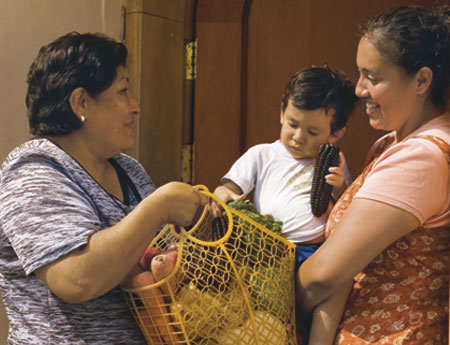
“No matter where [a family may] go, a Church family awaits them” (Boyd K. Packer).
A Place of Influence
Sister Belle S. Spafford was called as the ninth Relief Society general president in April 1945, and President George Albert Smith was set apart as the eighth President of the Church about six weeks later. President Smith encouraged Sister Spafford and all Relief Society sisters to provide temporal support for people who continued to suffer from the effects of World War II. He also asked them to make their influence felt among all the women of the world. He said, “When the Prophet Joseph Smith turned the key for the emancipation of womankind, it was turned for all the world.”8
The Relief Society Building, a Center of Influence
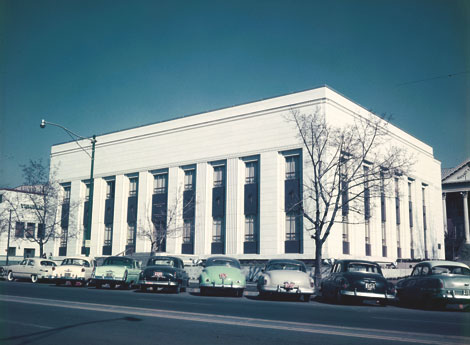
Relief Society Building, Salt Lake City, Utah, 1956
In October 1945, plans were announced to erect a Relief Society building.9 In October 1947, the First Presidency approved a plan proposed by Sister Belle S. Spafford: each member of the Relief Society, which then numbered 100,000, was asked to donate five dollars to the project. Sisters from all over the world sent donations. Some sent artifacts from their homelands to beautify the interior of the building. In one year, sisters raised $554,016.
Sister Spafford declared: “This achievement represents great monetary value, but not monetary value alone. Herein are represented many intangible values—values of supreme worth—appreciation for the honored position accorded women in the gospel plan; testimony of the divinity of the work of the society; and gratitude for the opportunity given the sisters of the Church to serve … ; loyalty to leadership; unselfish devotion to a great cause. It is a reflection of the greatness that is inherent within the society.”10
The building, located just northeast of the Salt Lake Temple, was dedicated on October 3, 1956. In the dedicatory prayer, President David O. McKay, the ninth President of the Church, spoke of the worldwide influence that would emanate from the building: “To make more effective their service to the needy and suffering to those in the Church and in the World, the Relief Society has erected with the aid of the Church membership this beautiful Relief Society home.”11
Since 1984 the building has also housed the offices of the Young Women general presidency and the Primary general presidency.
Influence among Those of Other Faiths
“When we qualify ourselves by our worthiness, when we strive with faith nothing wavering to fulfill the duties appointed to us, when we seek the inspiration of the Almighty in the performance of our responsibilities, we can achieve the miraculous.”
Thomas S. Monson
In Conference Report, Apr. 1988, 52; or Ensign, May 1988, 43
Sister Spafford learned a great lesson from President George Albert Smith about sharing the Church’s values with the women of the world. Soon after she was sustained as Relief Society general president, “a letter came from the National Council of Women, announcing their annual meeting to be held in New York City.
“Sister Spafford had attended those meetings before, and in view of her previous experience, she and her counselors carefully considered the invitation for several weeks.
“They decided to recommend to the President of the Church that the Relief Society terminate its membership in those councils. They prepared a statement of recommendation, listing all of the reasons for so doing.
“Trembling and uncertain, Sister Spafford placed the paper on the desk of President George Albert Smith, saying, ‘The Relief Society Presidency wishes to recommend that the General Board terminate its membership in the National Council and in the International Council of Women, for the reasons listed on this paper.’
“President Smith carefully read the paper. Had they not held membership for well over half a century? he inquired.
“Sister Spafford explained how costly it was to go to New York, the time it took, and described the humiliation they occasionally experienced. She recommended that they withdraw because ‘we don’t get a thing from these councils.’
“This wise, old prophet tipped back in his chair and looked at her with a disturbed expression. ‘You want to withdraw because you don’t get anything out of it?’ he questioned.
“‘That is our feeling,’ she replied.
“‘Tell me,’ he said, ‘what is it that you are putting into it?
“‘Sister Spafford,’ he continued, ‘you surprise me. Do you always think in terms of what you get? Don’t you think also in terms of what you have to give?’
“He returned that paper to her and extended his hand. With considerable firmness he said, ‘You continue your membership in these councils and make your influence felt.’”12
She did make her influence felt. She participated in the National Council of Women and the International Council of Women and held leadership positions in those organizations for years. She stood strong for the principles of the gospel of Jesus Christ and for the purposes of Relief Society.
Every time Sister Spafford went to the International Council of Women (ICW), she was assigned to the “social and moral welfare” session. She recounted:
“At one time I protested going back into the social and moral welfare [session], and I was very friendly at that time with the ICW president. … I said, ‘I go all the time to this session, and it’s just getting so sordid that I’d like a change.’ She said, ‘Well, you’re certainly entitled to one, and I’ll see that you get it.’
“Then she came back and said, ‘We can’t grant your request because your own council insists that you remain in the social and moral welfare.’ She said, ‘It may be of interest to you to know the reason. Your national president says you always stand by the position of your Church in these matters and they know the position of the Mormon Church and they feel there is safety in having you there.’”13
Women in these organizations knew that their friend Belle Spafford would stand by the Church’s principles, and they needed that kind of wisdom and strength. In 1954 she was chosen as the leader of the United States delegation at the International Council of Women in Helsinki, Finland. As she led a grand march at the opening of the conference, her thoughts went back in time:
“As I looked out at the glittering audience made up of people of many nations … , my mind suddenly flashed back to the words of our pioneer [Relief Society] leaders … ‘standing as we do at the head of the women of the world,’ … ‘for the rights of the women of Zion and the rights of the women of all nations.’ … I knew that our pioneer women leaders had been given by divine insight a knowledge of the destiny of Relief Society. … It is my conviction that the time had come for Relief Society’s influence to be felt worldwide among womankind.”14
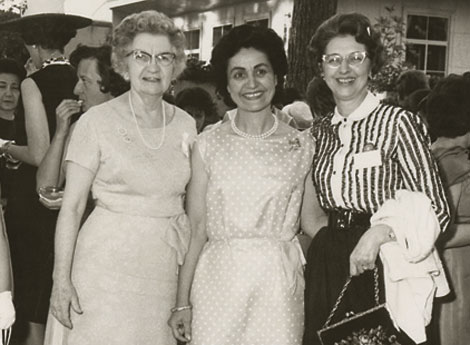
Sister Belle S. Spafford, left, at an International Council of Women convention
In 1987 the First Presidency counseled the Relief Society to withdraw from the National Council of Women and the International Council of Women. The time had come for the Relief Society general presidency to focus more energy on their rapidly growing worldwide organization rather than on other nationwide and worldwide causes. But as the Church has grown, Latter-day Saint women have continued to make their influence felt all over the world—in their communities, schools, and worthy local organizations. They have followed the pattern established by President Smith and Sister Spafford, thinking in terms of what they can give, not what they might get.
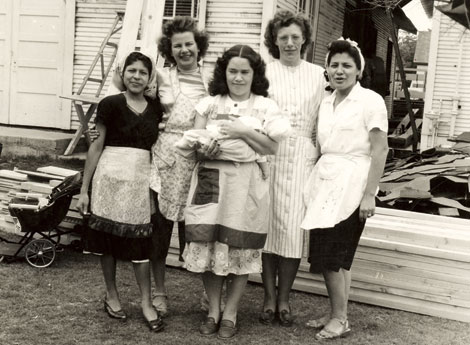
Relief Society sisters and full-time missionaries in San Antonio, Texas, about 1950
Nurturing and Teaching Investigators and New Converts
With the worldwide growth of the Church, Relief Society has been a place of influence for investigators and new converts. This influence has included giving new members opportunities to serve and lead. Sister Silvia H. Allred, a counselor in the Relief Society general presidency, told of her mother, Hilda Alvarenga, serving as a branch Relief Society president in San Salvador, El Salvador:
“My mother was a recent convert to the Church when she was called to be the Relief Society president in our small branch in San Salvador. She told the branch president that she was inexperienced, unprepared, and inadequate. She was in her 30s, had very little formal education, and her whole life had been devoted to the care of her husband and seven children. But the branch president called her anyway.
Hilda Alvarenga
“I watched my mother rise to the occasion. While serving, she learned leadership skills and developed new gifts such as teaching, public speaking, and planning and organizing meetings, activities, and service projects. She influenced the women in the branch. She served them and taught them to serve one another. The sisters loved and respected her. She helped other women to discover, use, and develop gifts and talents; she helped them become builders of the kingdom and of strong, spiritual families. She stayed faithful to the temple covenants she made. When she passed away, she was at peace with her Maker.
“A sister who served with her as a counselor in the Relief Society wrote me a letter years later: ‘Your mother was the person who taught me the way to become what I am now. From her, I learned charity, kindness, honesty, and responsibility in our callings. She was my mentor and my example. I am now 80 years old, but I have stayed faithful to the Savior and His gospel. I have served a mission, and the Lord has blessed me greatly.’”15
This devoted Relief Society president helped strengthen the testimonies of sisters who were already members of the branch. She also nurtured the faith of women who were investigating the Church and those who had recently been baptized and confirmed. She led efforts to make Relief Society a welcoming, nurturing place.
Influencing Others by Sharing the Gospel
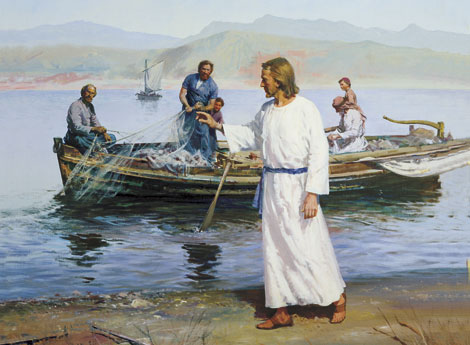
Like the Savior’s ancient Apostles, Relief Society sisters can be instruments in God’s hands.
Christ Calling Peter and Andrew, by Harry Anderson. © IRI.
Not long after President and Sister Packer visited that small circle of sisters in Czechoslovakia, a young woman who was searching for spiritual refuge, love, and meaning in her life was drawn into that very circle. Her name was Olga Kovářová, and at the time she was a doctoral student at a university in the city of Brno. The university imposed the teachings of atheism on students. Olga felt that students and others all around her were directionless. She hungered for a deeper spiritual life, and she sensed that same hunger among her friends and colleagues.
During Olga’s time at the university, she met Otakar Vojkůvka, a 75-year-old Latter-day Saint man. She later recalled: “He appeared to me seventy-five in his age but in his heart nearer eighteen and full of joy. This was so unusual in Czechoslovakia at that time of cynicism. … I saw that he was not only educated but knew how to live joyfully.” She asked him and his family about the meaning of life, and eventually they introduced her to other Church members. She wanted to know how they found joy and where they read about God. They gave her a copy of the Book of Mormon, which she began reading eagerly.
Olga was converted to the restored gospel, and she decided to be baptized. She had to be baptized in the woods at night to avoid drawing attention to a religious activity. Unfortunately, many fishermen were in the woods on the night of her baptism. But after Olga and her friends waited and finally offered an earnest prayer, the fishermen left.
A Church member who attended Olga’s baptism asked her, “Do you know why there were many fishermen by the water tonight?” Then he said, “Remember that Jesus, as he walked by the Sea of Galilee, said to Simon Peter and Andrew, who were casting a net into the sea, ‘Follow me, and I will make you fishers of men.’” Olga felt that “his meaning was that I should soon be an instrument in God’s hands to bring young people into the Church.”
Olga did exactly that. She influenced many who were searching for truth and happiness. Because proselyting was not allowed in their country, she and the Vojkůvka family conducted a class they called “School of Wisdom.” In these settings, they taught moral and ethical values to help people find spirituality and joy in life. Many of their students felt the influence of the Spirit, and opportunities often opened for discussions with selected individuals about Heavenly Father and the gospel of Jesus Christ.16
Later, when Sister Barbara W. Winder was serving as the eleventh Relief Society general president, she had the opportunity to travel to Czechoslovakia with her husband, Richard W. Winder, who had served there as a young missionary years earlier. As they entered a home where a meeting would be held, a vibrant young woman approached them enthusiastically and said, “Welcome! My name is Olga, and I am the Relief Society president.” Brother and Sister Winder noted the light in her countenance and the Spirit of the Lord upon her. As the Relief Society president of her little branch, Olga Kovářová was an influence for good in a world of political oppression and religious persecution, and she helped provide refuge for those who joined the Church and became members of Relief Society. She helped save the souls of others by bringing them to Christ.
Sister Kovářová’s conversion story and her missionary work are a partial fulfillment of a prophecy of President Spencer W. Kimball, the twelfth President of the Church: “Much of the major growth that is coming to the Church in the last days will come because many of the good women of the world (in whom there is often such an inner sense of spirituality) will be drawn to the Church in large numbers. This will happen to the degree that the women of the Church reflect righteousness and articulateness in their lives and to the degree that the women of the Church are seen as distinct and different—in happy ways—from the women of the world.”17
Influencing Others through Service
In 1992, sisters all over the world celebrated the 150th anniversary of the Relief Society by participating in service projects in their communities. Through this effort, organized under the direction of general and local priesthood leaders, sisters shared the influence of Relief Society worldwide. Sister Elaine L. Jack, who was serving as the twelfth Relief Society general president at the time, said:
“We asked each of our local units to look to the needs of their own community and to decide what community service would be needed the most. Can you imagine what that did in this world?
“One of our Relief Society presidents went to the city council in a California city and said, ‘What are the things that you feel are needed in this community that we could do?’ And the men said, ‘You mean 20,000 groups throughout this world are going to be doing this same thing?’ And she said yes. And [one of the council members] said, ‘You’ll change the world.’ And I think we did … for the better. That was one of the unifying things. And [there was] such a variety of service. … [Sisters] made lap rugs in South Africa for those elderly in the home. … They planted flowers around [a] clock tower in Samoa. And they did so many things with homeless shelters or providing books for children or painting homes for unwed mothers, that sort of thing. We felt that throughout the world these community service projects were a great thing, both for the sisters and for the community.”18
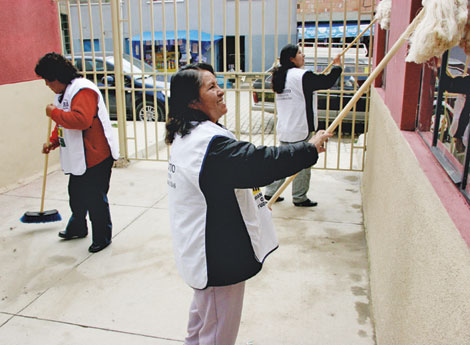
Service can change the world for the better.
Photograph © Jason Swensen.
Influencing Others through Literacy
As Relief Society sisters organized community service projects, Sister Jack and her counselors focused on a worldwide service effort: helping sisters learn to read. “We felt that women throughout the world needed to be able to read, and there were many who could not,” she said. “Can you imagine—if they didn’t know how to read, how could they teach their children, how could they improve their circumstances, how could they study the gospel? So we thought that there would be nothing that could be more beneficial than to promote a literacy effort. … But also our purpose was to encourage lifelong learning for every sister.”19
Thomas S. Monson
President Thomas S. Monson, the sixteenth President of the Church, once met a woman in Monroe, Louisiana, who had been blessed by this Relief Society service and who had shared the blessing with others. She approached him in an airport and said: “President Monson, before I joined the Church and became a member of the Relief Society, I could not read. I could not write. None of my family could.” She told President Monson that Relief Society sisters had taught her to read and that now she helped others learn to read. After talking with her, President Monson “reflected on the supreme happiness she must have felt when she opened her Bible and read for the first time the words of the Lord. … That day in Monroe, Louisiana,” he said, “I received a confirmation by the Spirit of your exalted objective of improving literacy among your sisters.”20
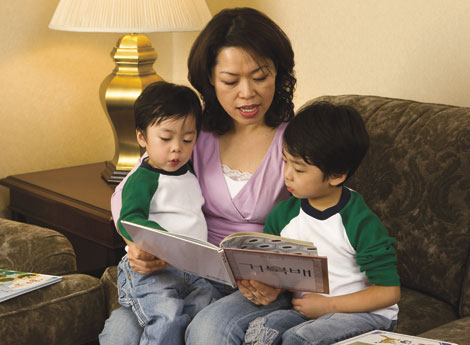
The ability to read helps women improve their circumstances, study the gospel, and teach their children.
Influencing and Strengthening Sisters in Wards and Branches
“You are members of the greatest women’s organization in the world, an organization which is a vital part of the kingdom of God on earth and which is so designed and operated that it helps its faithful members to gain eternal life in our Father’s kingdom.”
Joseph Fielding Smith
Relief Society Magazine, Dec. 1970, 883
Even as faithful Relief Society sisters have made their influence felt in their communities and throughout the world, they have not forgotten to strengthen each other in their own wards and branches. Sister Julie B. Beck, who later served as the fifteenth Relief Society general president, found sisterhood, refuge, and influence in Relief Society when she was a young, inexperienced mother and homemaker. She recalled:
“Relief Society should be organized, aligned, and mobilized to strengthen families and help our homes to be sacred sanctuaries from the world. I learned this years ago when I was newly married. My parents, who had been my neighbors, announced that they would be moving to another part of the world. I had relied on my mother’s nurturing, wise, and encouraging example. Now she was going to be gone for a long time. This was before e-mail, fax machines, cell phones, and Web cameras, and mail delivery was notoriously slow. One day before she left, I sat weeping with her and asked, ‘Who will be my mother?’ Mother thought carefully, and with the Spirit and power of revelation which comes to women of this kind, she said to me, ‘If I never come back, if you never see me again, if I’m never able to teach you another thing, you tie yourself to Relief Society. Relief Society will be your mother.’
“Mother knew that if I was sick, the sisters would take care of me, and when I had my babies, they would help me. But my mother’s greatest hope was that the sisters in Relief Society would be powerful, spiritual leaders for me. I began from that time to learn abundantly from women of stature and faith.”21
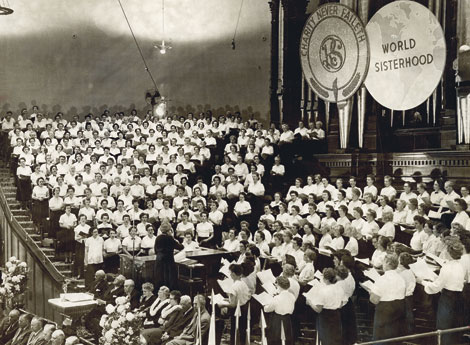
A Relief Society choir singing in the Salt Lake Tabernacle, 1956
An Ever-Expanding Circle of Sisters
Boyd K. Packer
The first time President Boyd K. Packer publicly told of his experience with the Relief Society sisters in Czechoslovakia, he was speaking at the general Relief Society meeting in 1980. He said, “I caught then the vision of a great circle of sisters.”22 In 1998 he shared the experience again, this time in a general conference address to the entire Church. He observed, “The Relief Society is more than a circle now; it is more like a fabric of lace spread across the continents.”23
Relief Society sisters are part of a divinely inspired organization that the Prophet Joseph Smith established under priesthood authority. As women participate in Relief Society and devote themselves to it, they will continue to provide refuge and sisterhood and be powerful influences for good. President Packer promised great blessings to sisters who serve in this cause:
“Your every need shall be fulfilled, now, and in the eternities; every neglect will be erased; every abuse will be corrected. All of this can come to you, and come quickly, when you devote yourself to Relief Society.
“Service in the Relief Society magnifies and sanctifies each individual sister. Your membership in Relief Society should be ever with you. When you devote yourself to the Relief Society and organize it and operate it and participate in it, you sustain the cause that will bless every woman who comes within its influence.”24
Strengthening Sisterhood through Expressions of Charity

“True charity is love in action. The need for charity is everywhere” (Thomas S. Monson).
In an address to Relief Society sisters, President Thomas S. Monson shared thoughts about how expressions of charity strengthen the ties of sisterhood in Relief Society:
“I consider charity—or ‘the pure love of Christ’—to be the opposite of criticism and judging. In speaking of charity, I do not at this moment have in mind the relief of the suffering through the giving of our substance. That, of course, is necessary and proper. Tonight, however, I have in mind the charity that manifests itself when we are tolerant of others and lenient toward their actions, the kind of charity that forgives, the kind of charity that is patient.
“I have in mind the charity that impels us to be sympathetic, compassionate, and merciful, not only in times of sickness and affliction and distress but also in times of weakness or error on the part of others.
“There is a serious need for the charity that gives attention to those who are unnoticed, hope to those who are discouraged, aid to those who are afflicted. True charity is love in action. The need for charity is everywhere.
“Needed is the charity which refuses to find satisfaction in hearing or in repeating the reports of misfortunes that come to others, unless by so doing, the unfortunate one may be benefited. …
“Charity is having patience with someone who has let us down. It is resisting the impulse to become offended easily. It is accepting weaknesses and shortcomings. It is accepting people as they truly are. It is looking beyond physical appearances to attributes that will not dim through time. It is resisting the impulse to categorize others.
“Charity, that pure love of Christ, is manifest when a group of young women from a singles ward travels hundreds of miles to attend the funeral services for the mother of one of their Relief Society sisters. Charity is shown when devoted visiting teachers return month after month, year after year to the same uninterested, somewhat critical sister. It is evident when an elderly widow is remembered and taken to ward functions and to Relief Society activities. It is felt when the sister sitting alone in Relief Society receives the invitation, ‘Come—sit by us.’
“In a hundred small ways, all of you wear the mantle of charity. Life is perfect for none of us. Rather than being judgmental and critical of each other, may we have the pure love of Christ for our fellow travelers in this journey through life. May we recognize that each one is doing her best to deal with the challenges which come her way, and may we strive to do our best to help out.
“Charity has been defined as ‘the highest, noblest, strongest kind of love,’ the ‘pure love of Christ … ; and whoso is found possessed of it at the last day, it shall be well with [her].’
“‘Charity never faileth.’ May this long-enduring Relief Society motto, this timeless truth, guide you in everything you do. May it permeate your very souls and find expression in all your thoughts and actions.”25

Charity is felt in the invitation “Come—sit by us.”